Integrating Renewable Energy Technologies for Sustainable Systems
VerifiedAdded on 2023/06/12
|13
|2632
|449
Report
AI Summary
This research investigates the integration of renewable energy technologies with conventional energy systems to enhance the sustainability of energy supply. It addresses the challenges associated with renewable energy consumption and aims to identify obstacles in integrating renewable technologies into conventional systems for improved electricity distribution. The literature review focuses on the concept of renewable energy technologies and the challenges in current electricity distribution systems. The study explores factors affecting the integration of renewable energy technologies with conventional resources, using data collected from secondary sources like online journals and books. A descriptive research design is employed, and data is analyzed qualitatively, creating themes related to renewable energy technologies to facilitate thematic analysis. The research covers the impact of renewable energy integration, analyzes factors causing issues, and recommends mitigation strategies.
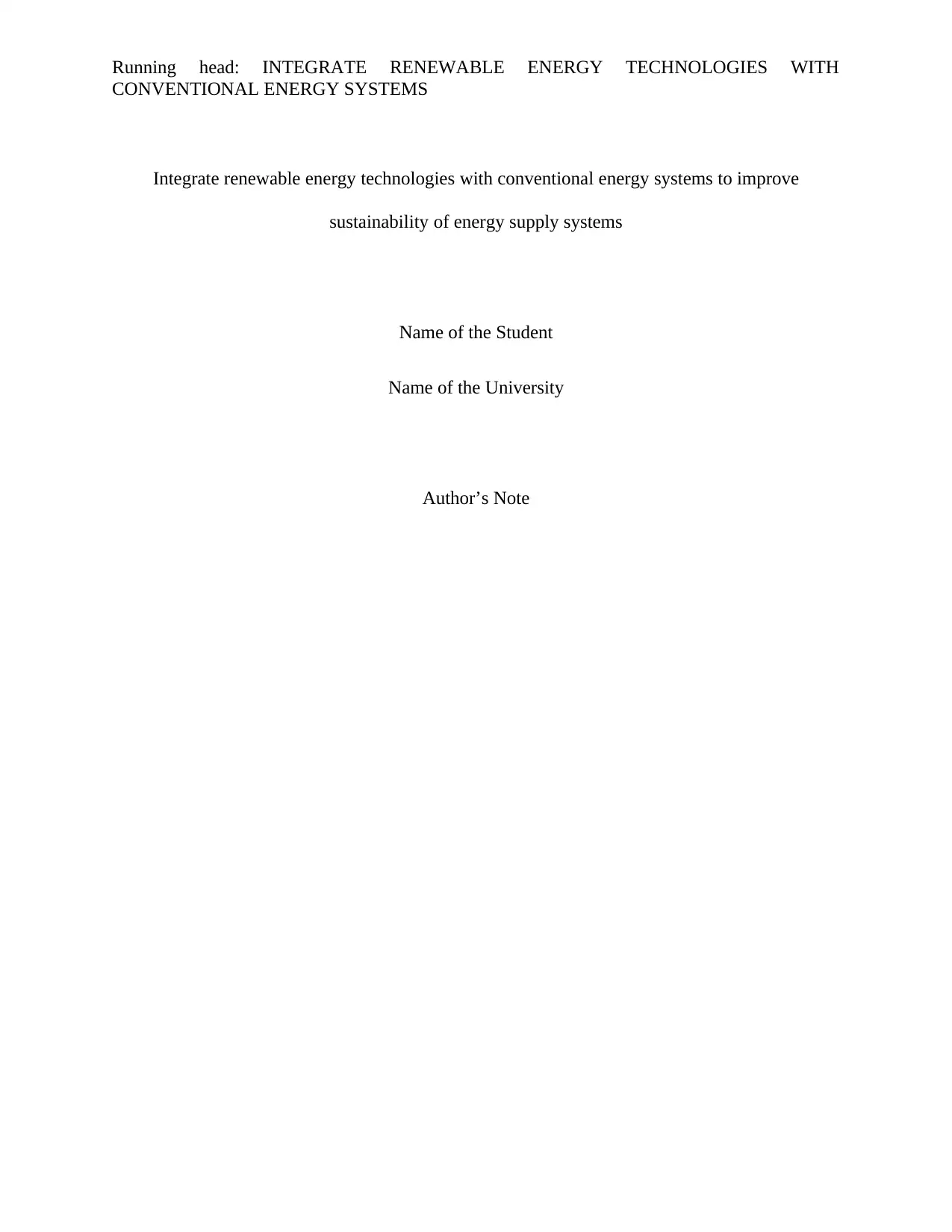
Running head: INTEGRATE RENEWABLE ENERGY TECHNOLOGIES WITH
CONVENTIONAL ENERGY SYSTEMS
Integrate renewable energy technologies with conventional energy systems to improve
sustainability of energy supply systems
Name of the Student
Name of the University
Author’s Note
CONVENTIONAL ENERGY SYSTEMS
Integrate renewable energy technologies with conventional energy systems to improve
sustainability of energy supply systems
Name of the Student
Name of the University
Author’s Note
Paraphrase This Document
Need a fresh take? Get an instant paraphrase of this document with our AI Paraphraser
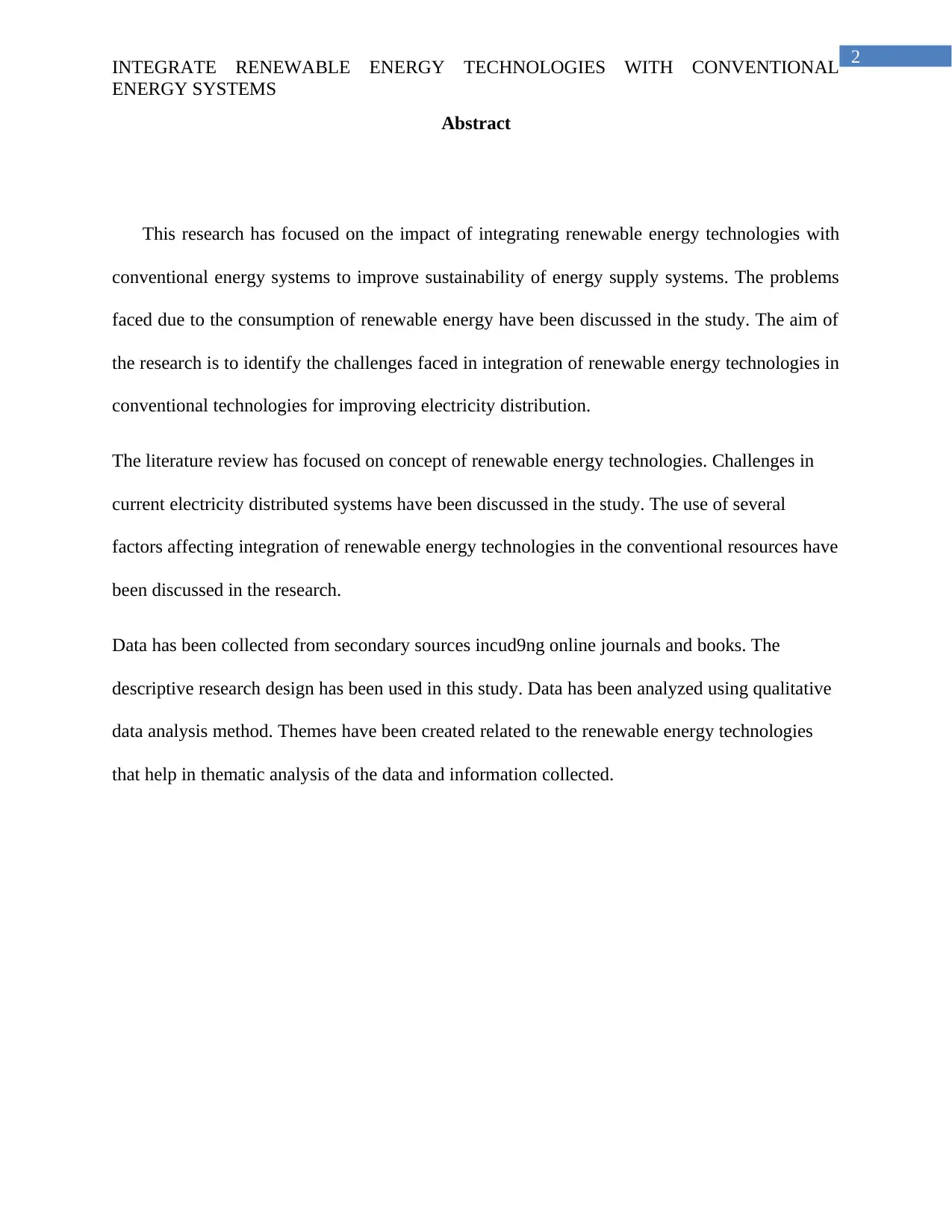
2
INTEGRATE RENEWABLE ENERGY TECHNOLOGIES WITH CONVENTIONAL
ENERGY SYSTEMS
Abstract
This research has focused on the impact of integrating renewable energy technologies with
conventional energy systems to improve sustainability of energy supply systems. The problems
faced due to the consumption of renewable energy have been discussed in the study. The aim of
the research is to identify the challenges faced in integration of renewable energy technologies in
conventional technologies for improving electricity distribution.
The literature review has focused on concept of renewable energy technologies. Challenges in
current electricity distributed systems have been discussed in the study. The use of several
factors affecting integration of renewable energy technologies in the conventional resources have
been discussed in the research.
Data has been collected from secondary sources incud9ng online journals and books. The
descriptive research design has been used in this study. Data has been analyzed using qualitative
data analysis method. Themes have been created related to the renewable energy technologies
that help in thematic analysis of the data and information collected.
INTEGRATE RENEWABLE ENERGY TECHNOLOGIES WITH CONVENTIONAL
ENERGY SYSTEMS
Abstract
This research has focused on the impact of integrating renewable energy technologies with
conventional energy systems to improve sustainability of energy supply systems. The problems
faced due to the consumption of renewable energy have been discussed in the study. The aim of
the research is to identify the challenges faced in integration of renewable energy technologies in
conventional technologies for improving electricity distribution.
The literature review has focused on concept of renewable energy technologies. Challenges in
current electricity distributed systems have been discussed in the study. The use of several
factors affecting integration of renewable energy technologies in the conventional resources have
been discussed in the research.
Data has been collected from secondary sources incud9ng online journals and books. The
descriptive research design has been used in this study. Data has been analyzed using qualitative
data analysis method. Themes have been created related to the renewable energy technologies
that help in thematic analysis of the data and information collected.
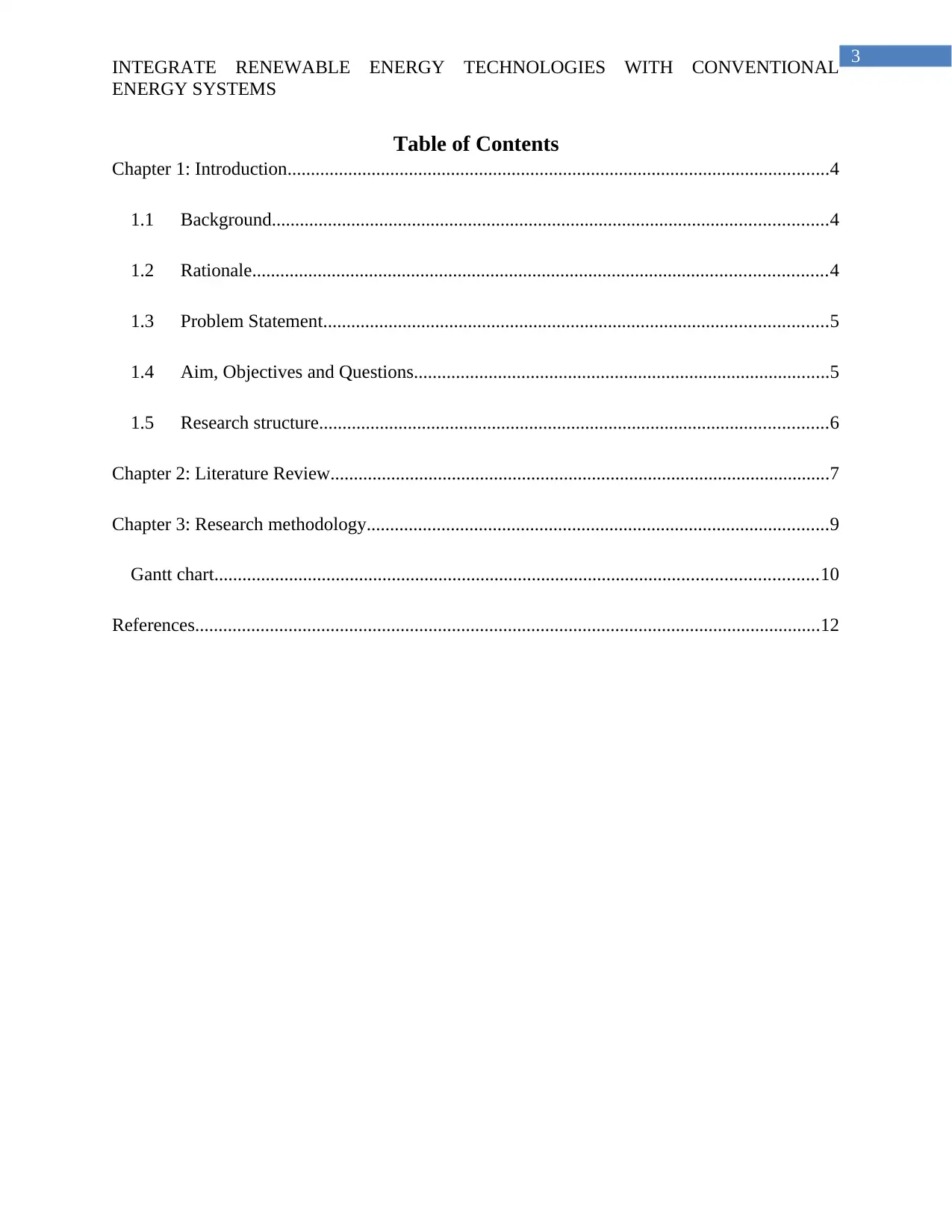
3
INTEGRATE RENEWABLE ENERGY TECHNOLOGIES WITH CONVENTIONAL
ENERGY SYSTEMS
Table of Contents
Chapter 1: Introduction....................................................................................................................4
1.1 Background.......................................................................................................................4
1.2 Rationale...........................................................................................................................4
1.3 Problem Statement............................................................................................................5
1.4 Aim, Objectives and Questions.........................................................................................5
1.5 Research structure.............................................................................................................6
Chapter 2: Literature Review...........................................................................................................7
Chapter 3: Research methodology...................................................................................................9
Gantt chart.................................................................................................................................10
References......................................................................................................................................12
INTEGRATE RENEWABLE ENERGY TECHNOLOGIES WITH CONVENTIONAL
ENERGY SYSTEMS
Table of Contents
Chapter 1: Introduction....................................................................................................................4
1.1 Background.......................................................................................................................4
1.2 Rationale...........................................................................................................................4
1.3 Problem Statement............................................................................................................5
1.4 Aim, Objectives and Questions.........................................................................................5
1.5 Research structure.............................................................................................................6
Chapter 2: Literature Review...........................................................................................................7
Chapter 3: Research methodology...................................................................................................9
Gantt chart.................................................................................................................................10
References......................................................................................................................................12
⊘ This is a preview!⊘
Do you want full access?
Subscribe today to unlock all pages.

Trusted by 1+ million students worldwide
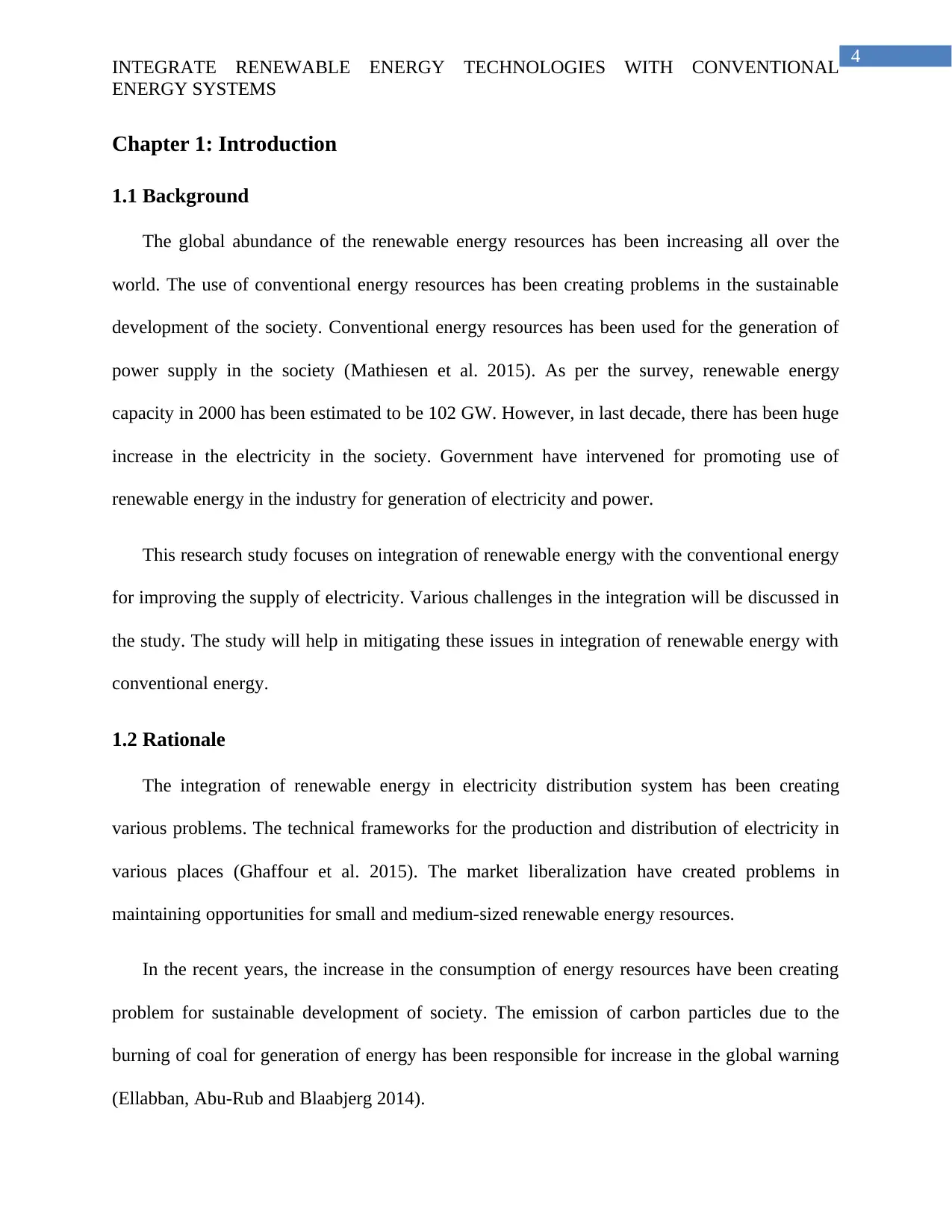
4
INTEGRATE RENEWABLE ENERGY TECHNOLOGIES WITH CONVENTIONAL
ENERGY SYSTEMS
Chapter 1: Introduction
1.1 Background
The global abundance of the renewable energy resources has been increasing all over the
world. The use of conventional energy resources has been creating problems in the sustainable
development of the society. Conventional energy resources has been used for the generation of
power supply in the society (Mathiesen et al. 2015). As per the survey, renewable energy
capacity in 2000 has been estimated to be 102 GW. However, in last decade, there has been huge
increase in the electricity in the society. Government have intervened for promoting use of
renewable energy in the industry for generation of electricity and power.
This research study focuses on integration of renewable energy with the conventional energy
for improving the supply of electricity. Various challenges in the integration will be discussed in
the study. The study will help in mitigating these issues in integration of renewable energy with
conventional energy.
1.2 Rationale
The integration of renewable energy in electricity distribution system has been creating
various problems. The technical frameworks for the production and distribution of electricity in
various places (Ghaffour et al. 2015). The market liberalization have created problems in
maintaining opportunities for small and medium-sized renewable energy resources.
In the recent years, the increase in the consumption of energy resources have been creating
problem for sustainable development of society. The emission of carbon particles due to the
burning of coal for generation of energy has been responsible for increase in the global warning
(Ellabban, Abu-Rub and Blaabjerg 2014).
INTEGRATE RENEWABLE ENERGY TECHNOLOGIES WITH CONVENTIONAL
ENERGY SYSTEMS
Chapter 1: Introduction
1.1 Background
The global abundance of the renewable energy resources has been increasing all over the
world. The use of conventional energy resources has been creating problems in the sustainable
development of the society. Conventional energy resources has been used for the generation of
power supply in the society (Mathiesen et al. 2015). As per the survey, renewable energy
capacity in 2000 has been estimated to be 102 GW. However, in last decade, there has been huge
increase in the electricity in the society. Government have intervened for promoting use of
renewable energy in the industry for generation of electricity and power.
This research study focuses on integration of renewable energy with the conventional energy
for improving the supply of electricity. Various challenges in the integration will be discussed in
the study. The study will help in mitigating these issues in integration of renewable energy with
conventional energy.
1.2 Rationale
The integration of renewable energy in electricity distribution system has been creating
various problems. The technical frameworks for the production and distribution of electricity in
various places (Ghaffour et al. 2015). The market liberalization have created problems in
maintaining opportunities for small and medium-sized renewable energy resources.
In the recent years, the increase in the consumption of energy resources have been creating
problem for sustainable development of society. The emission of carbon particles due to the
burning of coal for generation of energy has been responsible for increase in the global warning
(Ellabban, Abu-Rub and Blaabjerg 2014).
Paraphrase This Document
Need a fresh take? Get an instant paraphrase of this document with our AI Paraphraser
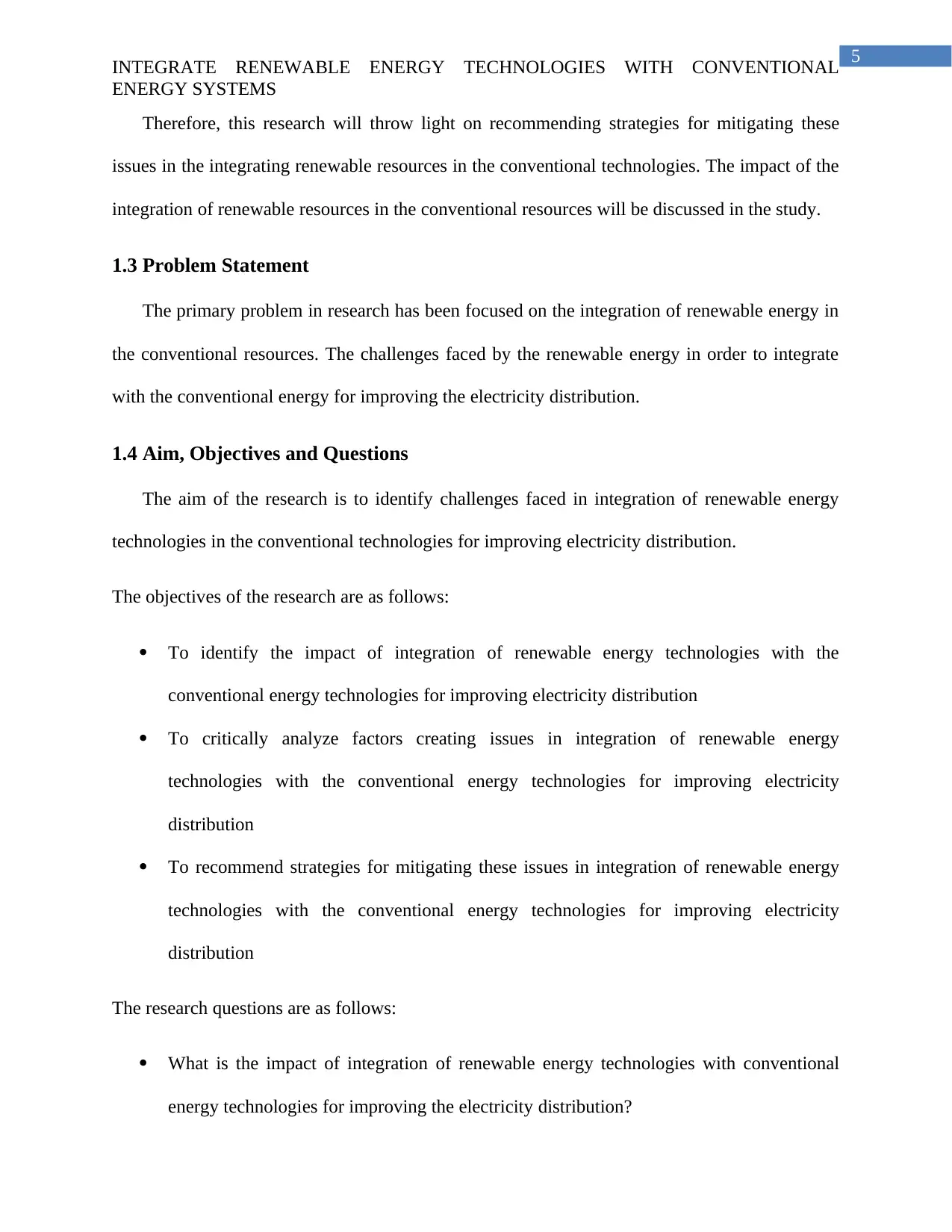
5
INTEGRATE RENEWABLE ENERGY TECHNOLOGIES WITH CONVENTIONAL
ENERGY SYSTEMS
Therefore, this research will throw light on recommending strategies for mitigating these
issues in the integrating renewable resources in the conventional technologies. The impact of the
integration of renewable resources in the conventional resources will be discussed in the study.
1.3 Problem Statement
The primary problem in research has been focused on the integration of renewable energy in
the conventional resources. The challenges faced by the renewable energy in order to integrate
with the conventional energy for improving the electricity distribution.
1.4 Aim, Objectives and Questions
The aim of the research is to identify challenges faced in integration of renewable energy
technologies in the conventional technologies for improving electricity distribution.
The objectives of the research are as follows:
To identify the impact of integration of renewable energy technologies with the
conventional energy technologies for improving electricity distribution
To critically analyze factors creating issues in integration of renewable energy
technologies with the conventional energy technologies for improving electricity
distribution
To recommend strategies for mitigating these issues in integration of renewable energy
technologies with the conventional energy technologies for improving electricity
distribution
The research questions are as follows:
What is the impact of integration of renewable energy technologies with conventional
energy technologies for improving the electricity distribution?
INTEGRATE RENEWABLE ENERGY TECHNOLOGIES WITH CONVENTIONAL
ENERGY SYSTEMS
Therefore, this research will throw light on recommending strategies for mitigating these
issues in the integrating renewable resources in the conventional technologies. The impact of the
integration of renewable resources in the conventional resources will be discussed in the study.
1.3 Problem Statement
The primary problem in research has been focused on the integration of renewable energy in
the conventional resources. The challenges faced by the renewable energy in order to integrate
with the conventional energy for improving the electricity distribution.
1.4 Aim, Objectives and Questions
The aim of the research is to identify challenges faced in integration of renewable energy
technologies in the conventional technologies for improving electricity distribution.
The objectives of the research are as follows:
To identify the impact of integration of renewable energy technologies with the
conventional energy technologies for improving electricity distribution
To critically analyze factors creating issues in integration of renewable energy
technologies with the conventional energy technologies for improving electricity
distribution
To recommend strategies for mitigating these issues in integration of renewable energy
technologies with the conventional energy technologies for improving electricity
distribution
The research questions are as follows:
What is the impact of integration of renewable energy technologies with conventional
energy technologies for improving the electricity distribution?
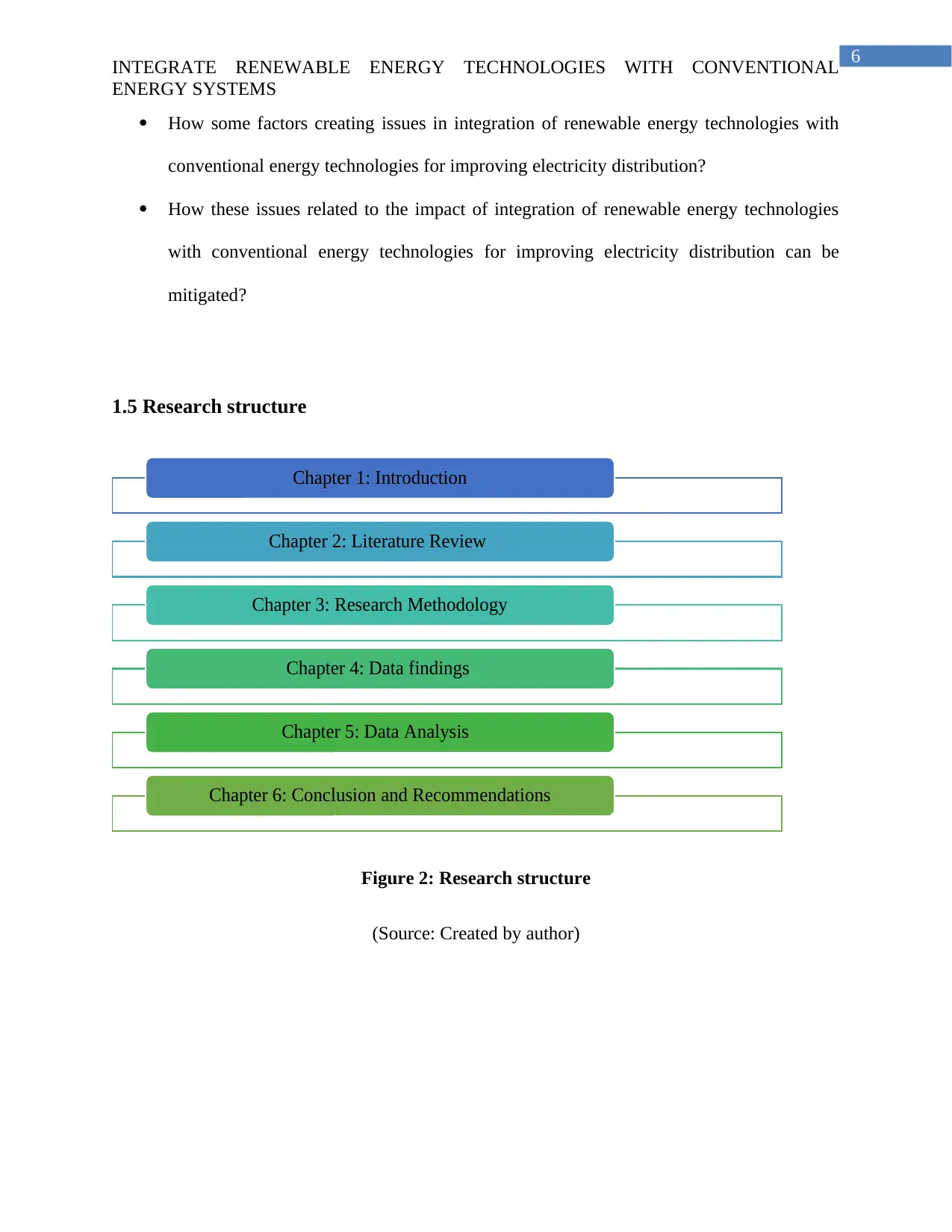
6
INTEGRATE RENEWABLE ENERGY TECHNOLOGIES WITH CONVENTIONAL
ENERGY SYSTEMS
How some factors creating issues in integration of renewable energy technologies with
conventional energy technologies for improving electricity distribution?
How these issues related to the impact of integration of renewable energy technologies
with conventional energy technologies for improving electricity distribution can be
mitigated?
1.5 Research structure
Figure 2: Research structure
(Source: Created by author)
Chapter 1: Introduction
Chapter 2: Literature Review
Chapter 3: Research Methodology
Chapter 4: Data findings
Chapter 5: Data Analysis
Chapter 6: Conclusion and Recommendations
INTEGRATE RENEWABLE ENERGY TECHNOLOGIES WITH CONVENTIONAL
ENERGY SYSTEMS
How some factors creating issues in integration of renewable energy technologies with
conventional energy technologies for improving electricity distribution?
How these issues related to the impact of integration of renewable energy technologies
with conventional energy technologies for improving electricity distribution can be
mitigated?
1.5 Research structure
Figure 2: Research structure
(Source: Created by author)
Chapter 1: Introduction
Chapter 2: Literature Review
Chapter 3: Research Methodology
Chapter 4: Data findings
Chapter 5: Data Analysis
Chapter 6: Conclusion and Recommendations
⊘ This is a preview!⊘
Do you want full access?
Subscribe today to unlock all pages.

Trusted by 1+ million students worldwide
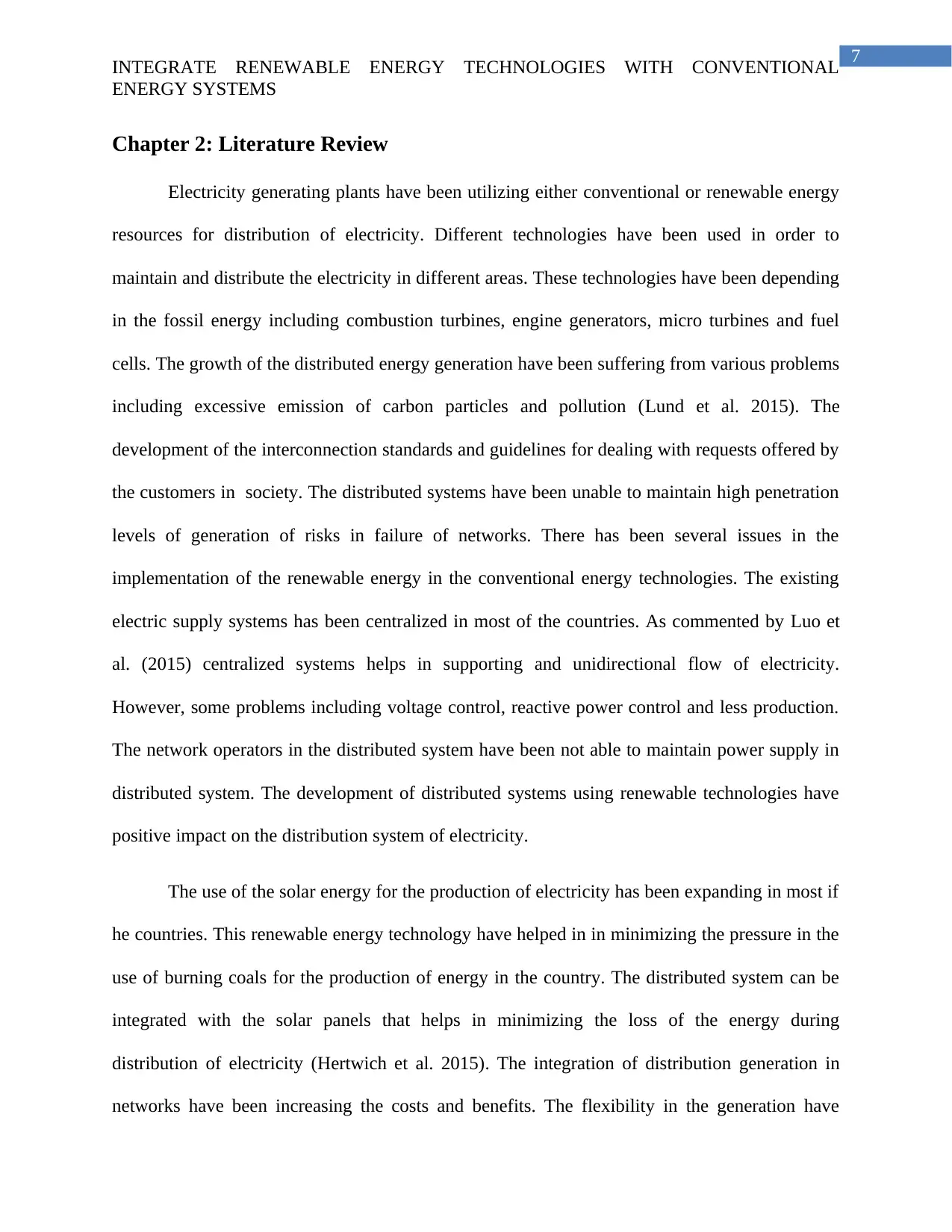
7
INTEGRATE RENEWABLE ENERGY TECHNOLOGIES WITH CONVENTIONAL
ENERGY SYSTEMS
Chapter 2: Literature Review
Electricity generating plants have been utilizing either conventional or renewable energy
resources for distribution of electricity. Different technologies have been used in order to
maintain and distribute the electricity in different areas. These technologies have been depending
in the fossil energy including combustion turbines, engine generators, micro turbines and fuel
cells. The growth of the distributed energy generation have been suffering from various problems
including excessive emission of carbon particles and pollution (Lund et al. 2015). The
development of the interconnection standards and guidelines for dealing with requests offered by
the customers in society. The distributed systems have been unable to maintain high penetration
levels of generation of risks in failure of networks. There has been several issues in the
implementation of the renewable energy in the conventional energy technologies. The existing
electric supply systems has been centralized in most of the countries. As commented by Luo et
al. (2015) centralized systems helps in supporting and unidirectional flow of electricity.
However, some problems including voltage control, reactive power control and less production.
The network operators in the distributed system have been not able to maintain power supply in
distributed system. The development of distributed systems using renewable technologies have
positive impact on the distribution system of electricity.
The use of the solar energy for the production of electricity has been expanding in most if
he countries. This renewable energy technology have helped in in minimizing the pressure in the
use of burning coals for the production of energy in the country. The distributed system can be
integrated with the solar panels that helps in minimizing the loss of the energy during
distribution of electricity (Hertwich et al. 2015). The integration of distribution generation in
networks have been increasing the costs and benefits. The flexibility in the generation have
INTEGRATE RENEWABLE ENERGY TECHNOLOGIES WITH CONVENTIONAL
ENERGY SYSTEMS
Chapter 2: Literature Review
Electricity generating plants have been utilizing either conventional or renewable energy
resources for distribution of electricity. Different technologies have been used in order to
maintain and distribute the electricity in different areas. These technologies have been depending
in the fossil energy including combustion turbines, engine generators, micro turbines and fuel
cells. The growth of the distributed energy generation have been suffering from various problems
including excessive emission of carbon particles and pollution (Lund et al. 2015). The
development of the interconnection standards and guidelines for dealing with requests offered by
the customers in society. The distributed systems have been unable to maintain high penetration
levels of generation of risks in failure of networks. There has been several issues in the
implementation of the renewable energy in the conventional energy technologies. The existing
electric supply systems has been centralized in most of the countries. As commented by Luo et
al. (2015) centralized systems helps in supporting and unidirectional flow of electricity.
However, some problems including voltage control, reactive power control and less production.
The network operators in the distributed system have been not able to maintain power supply in
distributed system. The development of distributed systems using renewable technologies have
positive impact on the distribution system of electricity.
The use of the solar energy for the production of electricity has been expanding in most if
he countries. This renewable energy technology have helped in in minimizing the pressure in the
use of burning coals for the production of energy in the country. The distributed system can be
integrated with the solar panels that helps in minimizing the loss of the energy during
distribution of electricity (Hertwich et al. 2015). The integration of distribution generation in
networks have been increasing the costs and benefits. The flexibility in the generation have
Paraphrase This Document
Need a fresh take? Get an instant paraphrase of this document with our AI Paraphraser
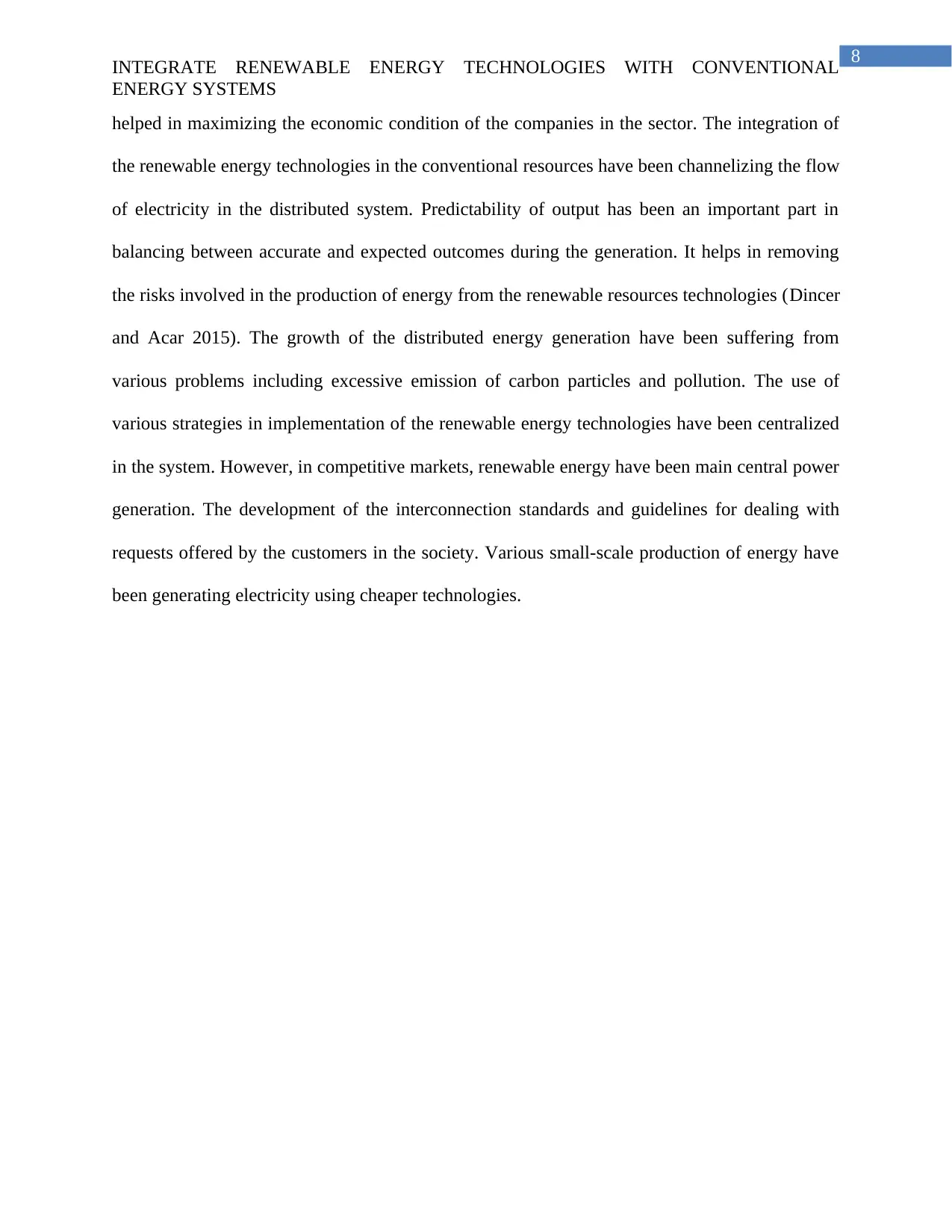
8
INTEGRATE RENEWABLE ENERGY TECHNOLOGIES WITH CONVENTIONAL
ENERGY SYSTEMS
helped in maximizing the economic condition of the companies in the sector. The integration of
the renewable energy technologies in the conventional resources have been channelizing the flow
of electricity in the distributed system. Predictability of output has been an important part in
balancing between accurate and expected outcomes during the generation. It helps in removing
the risks involved in the production of energy from the renewable resources technologies (Dincer
and Acar 2015). The growth of the distributed energy generation have been suffering from
various problems including excessive emission of carbon particles and pollution. The use of
various strategies in implementation of the renewable energy technologies have been centralized
in the system. However, in competitive markets, renewable energy have been main central power
generation. The development of the interconnection standards and guidelines for dealing with
requests offered by the customers in the society. Various small-scale production of energy have
been generating electricity using cheaper technologies.
INTEGRATE RENEWABLE ENERGY TECHNOLOGIES WITH CONVENTIONAL
ENERGY SYSTEMS
helped in maximizing the economic condition of the companies in the sector. The integration of
the renewable energy technologies in the conventional resources have been channelizing the flow
of electricity in the distributed system. Predictability of output has been an important part in
balancing between accurate and expected outcomes during the generation. It helps in removing
the risks involved in the production of energy from the renewable resources technologies (Dincer
and Acar 2015). The growth of the distributed energy generation have been suffering from
various problems including excessive emission of carbon particles and pollution. The use of
various strategies in implementation of the renewable energy technologies have been centralized
in the system. However, in competitive markets, renewable energy have been main central power
generation. The development of the interconnection standards and guidelines for dealing with
requests offered by the customers in the society. Various small-scale production of energy have
been generating electricity using cheaper technologies.
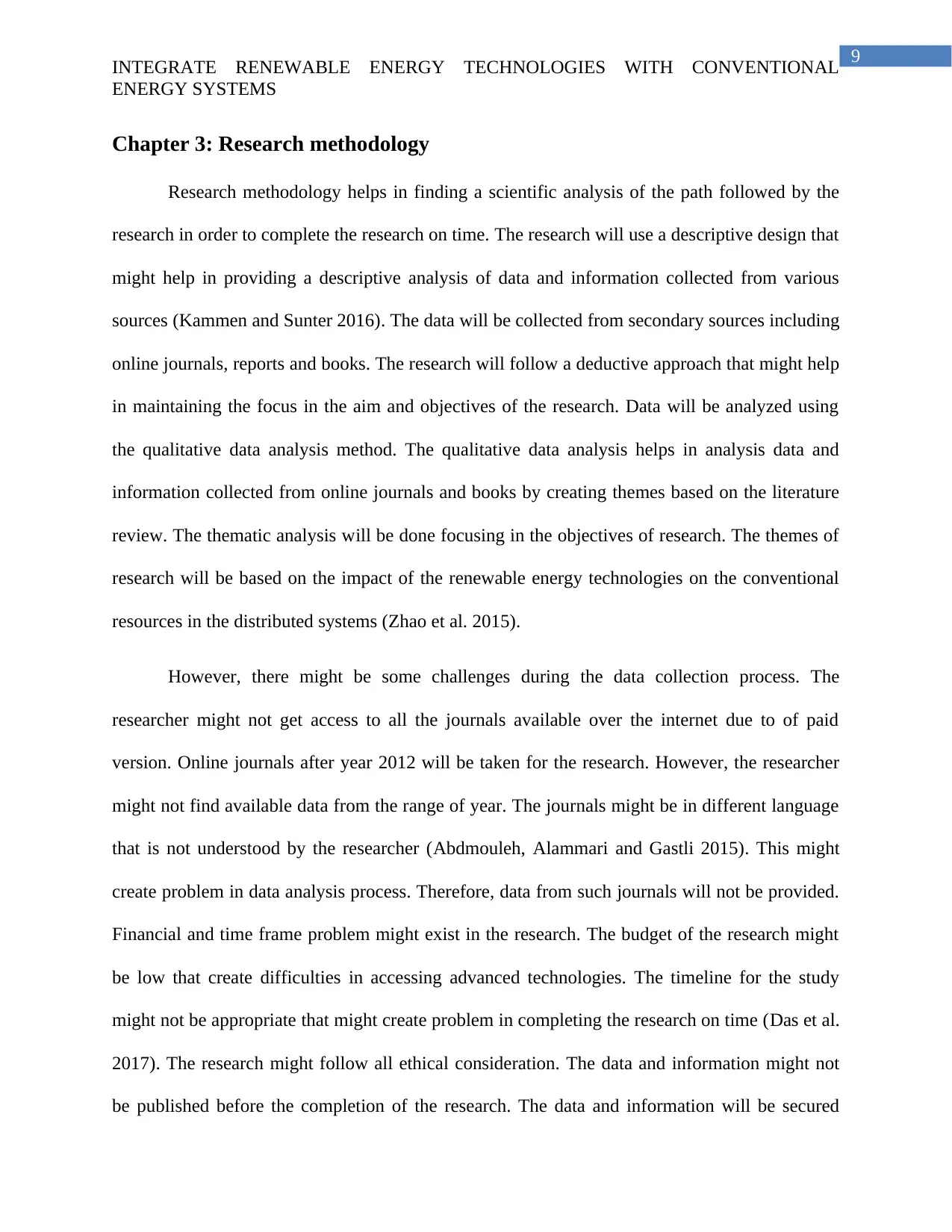
9
INTEGRATE RENEWABLE ENERGY TECHNOLOGIES WITH CONVENTIONAL
ENERGY SYSTEMS
Chapter 3: Research methodology
Research methodology helps in finding a scientific analysis of the path followed by the
research in order to complete the research on time. The research will use a descriptive design that
might help in providing a descriptive analysis of data and information collected from various
sources (Kammen and Sunter 2016). The data will be collected from secondary sources including
online journals, reports and books. The research will follow a deductive approach that might help
in maintaining the focus in the aim and objectives of the research. Data will be analyzed using
the qualitative data analysis method. The qualitative data analysis helps in analysis data and
information collected from online journals and books by creating themes based on the literature
review. The thematic analysis will be done focusing in the objectives of research. The themes of
research will be based on the impact of the renewable energy technologies on the conventional
resources in the distributed systems (Zhao et al. 2015).
However, there might be some challenges during the data collection process. The
researcher might not get access to all the journals available over the internet due to of paid
version. Online journals after year 2012 will be taken for the research. However, the researcher
might not find available data from the range of year. The journals might be in different language
that is not understood by the researcher (Abdmouleh, Alammari and Gastli 2015). This might
create problem in data analysis process. Therefore, data from such journals will not be provided.
Financial and time frame problem might exist in the research. The budget of the research might
be low that create difficulties in accessing advanced technologies. The timeline for the study
might not be appropriate that might create problem in completing the research on time (Das et al.
2017). The research might follow all ethical consideration. The data and information might not
be published before the completion of the research. The data and information will be secured
INTEGRATE RENEWABLE ENERGY TECHNOLOGIES WITH CONVENTIONAL
ENERGY SYSTEMS
Chapter 3: Research methodology
Research methodology helps in finding a scientific analysis of the path followed by the
research in order to complete the research on time. The research will use a descriptive design that
might help in providing a descriptive analysis of data and information collected from various
sources (Kammen and Sunter 2016). The data will be collected from secondary sources including
online journals, reports and books. The research will follow a deductive approach that might help
in maintaining the focus in the aim and objectives of the research. Data will be analyzed using
the qualitative data analysis method. The qualitative data analysis helps in analysis data and
information collected from online journals and books by creating themes based on the literature
review. The thematic analysis will be done focusing in the objectives of research. The themes of
research will be based on the impact of the renewable energy technologies on the conventional
resources in the distributed systems (Zhao et al. 2015).
However, there might be some challenges during the data collection process. The
researcher might not get access to all the journals available over the internet due to of paid
version. Online journals after year 2012 will be taken for the research. However, the researcher
might not find available data from the range of year. The journals might be in different language
that is not understood by the researcher (Abdmouleh, Alammari and Gastli 2015). This might
create problem in data analysis process. Therefore, data from such journals will not be provided.
Financial and time frame problem might exist in the research. The budget of the research might
be low that create difficulties in accessing advanced technologies. The timeline for the study
might not be appropriate that might create problem in completing the research on time (Das et al.
2017). The research might follow all ethical consideration. The data and information might not
be published before the completion of the research. The data and information will be secured
⊘ This is a preview!⊘
Do you want full access?
Subscribe today to unlock all pages.

Trusted by 1+ million students worldwide
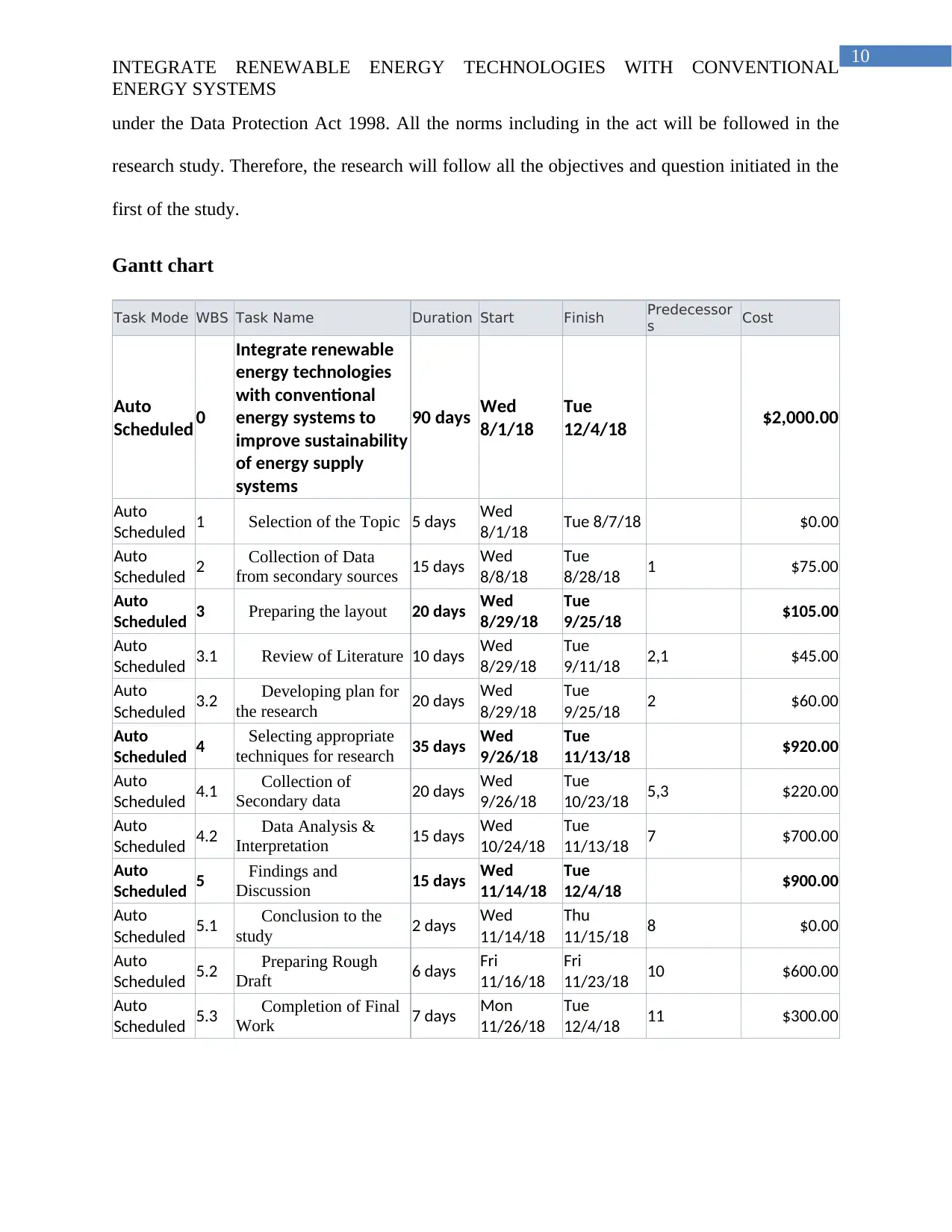
10
INTEGRATE RENEWABLE ENERGY TECHNOLOGIES WITH CONVENTIONAL
ENERGY SYSTEMS
under the Data Protection Act 1998. All the norms including in the act will be followed in the
research study. Therefore, the research will follow all the objectives and question initiated in the
first of the study.
Gantt chart
Task Mode WBS Task Name Duration Start Finish Predecessor
s Cost
Auto
Scheduled 0
Integrate renewable
energy technologies
with conventional
energy systems to
improve sustainability
of energy supply
systems
90 days Wed
8/1/18
Tue
12/4/18 $2,000.00
Auto
Scheduled 1 Selection of the Topic 5 days Wed
8/1/18 Tue 8/7/18 $0.00
Auto
Scheduled 2 Collection of Data
from secondary sources 15 days Wed
8/8/18
Tue
8/28/18 1 $75.00
Auto
Scheduled 3 Preparing the layout 20 days Wed
8/29/18
Tue
9/25/18 $105.00
Auto
Scheduled 3.1 Review of Literature 10 days Wed
8/29/18
Tue
9/11/18 2,1 $45.00
Auto
Scheduled 3.2 Developing plan for
the research 20 days Wed
8/29/18
Tue
9/25/18 2 $60.00
Auto
Scheduled 4 Selecting appropriate
techniques for research 35 days Wed
9/26/18
Tue
11/13/18 $920.00
Auto
Scheduled 4.1 Collection of
Secondary data 20 days Wed
9/26/18
Tue
10/23/18 5,3 $220.00
Auto
Scheduled 4.2 Data Analysis &
Interpretation 15 days Wed
10/24/18
Tue
11/13/18 7 $700.00
Auto
Scheduled 5 Findings and
Discussion 15 days Wed
11/14/18
Tue
12/4/18 $900.00
Auto
Scheduled 5.1 Conclusion to the
study 2 days Wed
11/14/18
Thu
11/15/18 8 $0.00
Auto
Scheduled 5.2 Preparing Rough
Draft 6 days Fri
11/16/18
Fri
11/23/18 10 $600.00
Auto
Scheduled 5.3 Completion of Final
Work 7 days Mon
11/26/18
Tue
12/4/18 11 $300.00
INTEGRATE RENEWABLE ENERGY TECHNOLOGIES WITH CONVENTIONAL
ENERGY SYSTEMS
under the Data Protection Act 1998. All the norms including in the act will be followed in the
research study. Therefore, the research will follow all the objectives and question initiated in the
first of the study.
Gantt chart
Task Mode WBS Task Name Duration Start Finish Predecessor
s Cost
Auto
Scheduled 0
Integrate renewable
energy technologies
with conventional
energy systems to
improve sustainability
of energy supply
systems
90 days Wed
8/1/18
Tue
12/4/18 $2,000.00
Auto
Scheduled 1 Selection of the Topic 5 days Wed
8/1/18 Tue 8/7/18 $0.00
Auto
Scheduled 2 Collection of Data
from secondary sources 15 days Wed
8/8/18
Tue
8/28/18 1 $75.00
Auto
Scheduled 3 Preparing the layout 20 days Wed
8/29/18
Tue
9/25/18 $105.00
Auto
Scheduled 3.1 Review of Literature 10 days Wed
8/29/18
Tue
9/11/18 2,1 $45.00
Auto
Scheduled 3.2 Developing plan for
the research 20 days Wed
8/29/18
Tue
9/25/18 2 $60.00
Auto
Scheduled 4 Selecting appropriate
techniques for research 35 days Wed
9/26/18
Tue
11/13/18 $920.00
Auto
Scheduled 4.1 Collection of
Secondary data 20 days Wed
9/26/18
Tue
10/23/18 5,3 $220.00
Auto
Scheduled 4.2 Data Analysis &
Interpretation 15 days Wed
10/24/18
Tue
11/13/18 7 $700.00
Auto
Scheduled 5 Findings and
Discussion 15 days Wed
11/14/18
Tue
12/4/18 $900.00
Auto
Scheduled 5.1 Conclusion to the
study 2 days Wed
11/14/18
Thu
11/15/18 8 $0.00
Auto
Scheduled 5.2 Preparing Rough
Draft 6 days Fri
11/16/18
Fri
11/23/18 10 $600.00
Auto
Scheduled 5.3 Completion of Final
Work 7 days Mon
11/26/18
Tue
12/4/18 11 $300.00
Paraphrase This Document
Need a fresh take? Get an instant paraphrase of this document with our AI Paraphraser
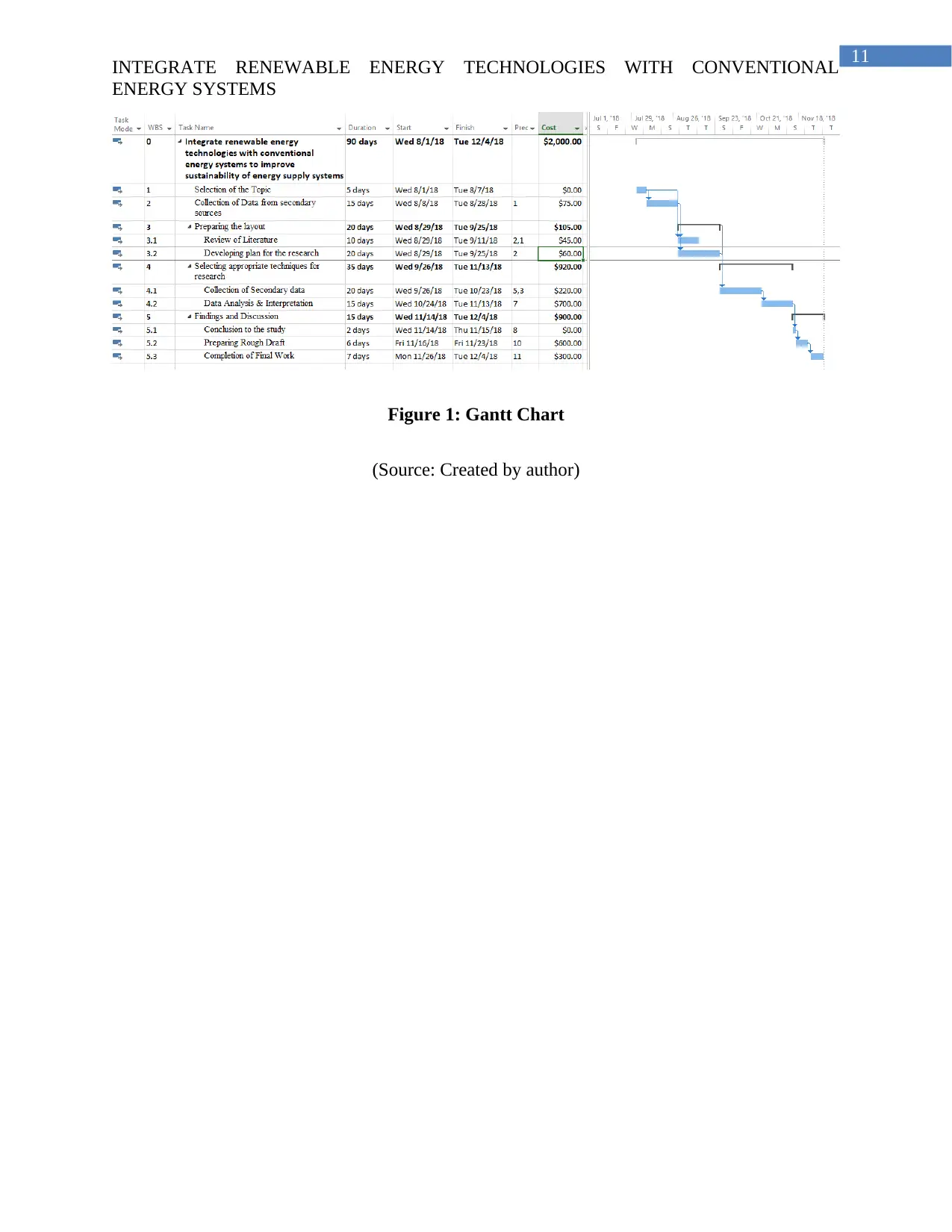
11
INTEGRATE RENEWABLE ENERGY TECHNOLOGIES WITH CONVENTIONAL
ENERGY SYSTEMS
Figure 1: Gantt Chart
(Source: Created by author)
INTEGRATE RENEWABLE ENERGY TECHNOLOGIES WITH CONVENTIONAL
ENERGY SYSTEMS
Figure 1: Gantt Chart
(Source: Created by author)
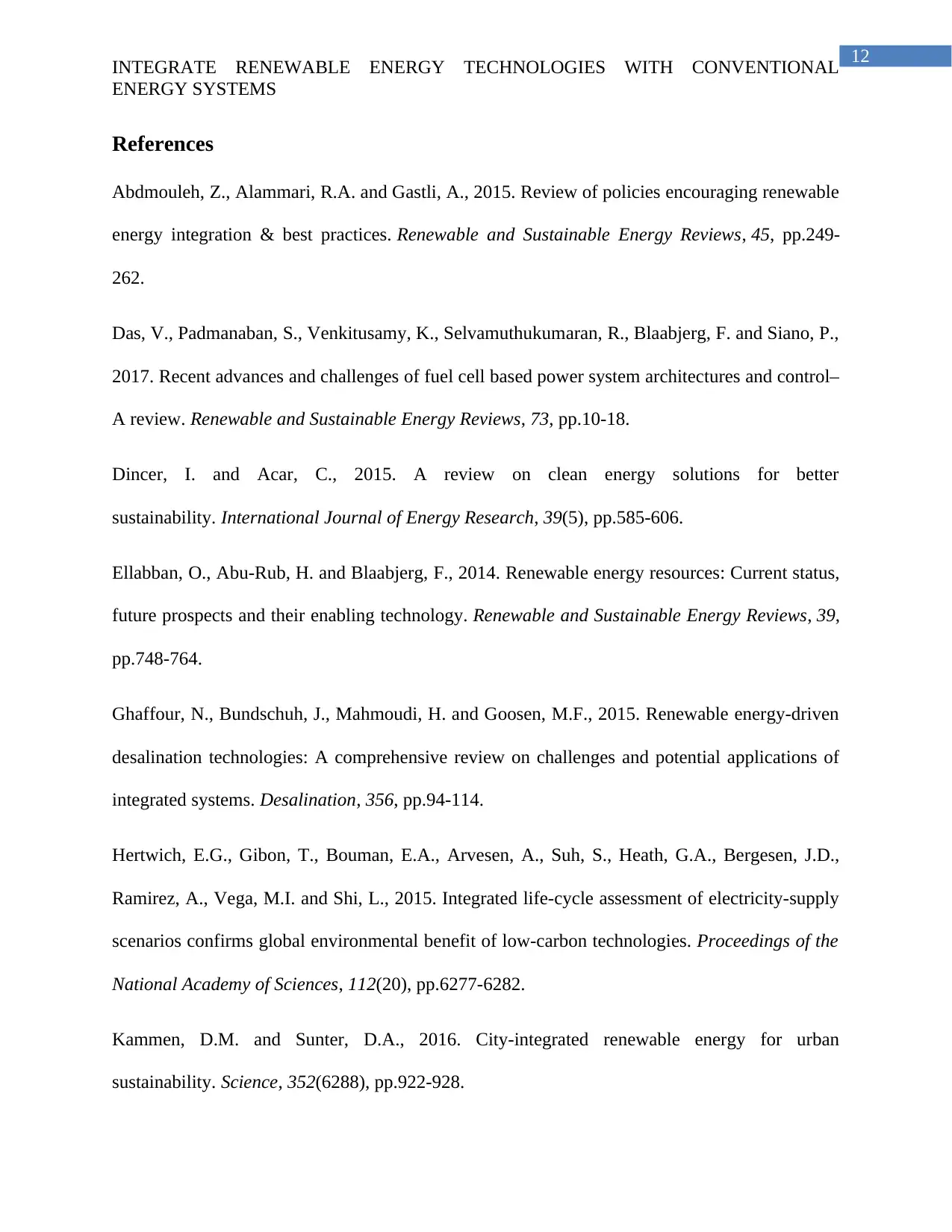
12
INTEGRATE RENEWABLE ENERGY TECHNOLOGIES WITH CONVENTIONAL
ENERGY SYSTEMS
References
Abdmouleh, Z., Alammari, R.A. and Gastli, A., 2015. Review of policies encouraging renewable
energy integration & best practices. Renewable and Sustainable Energy Reviews, 45, pp.249-
262.
Das, V., Padmanaban, S., Venkitusamy, K., Selvamuthukumaran, R., Blaabjerg, F. and Siano, P.,
2017. Recent advances and challenges of fuel cell based power system architectures and control–
A review. Renewable and Sustainable Energy Reviews, 73, pp.10-18.
Dincer, I. and Acar, C., 2015. A review on clean energy solutions for better
sustainability. International Journal of Energy Research, 39(5), pp.585-606.
Ellabban, O., Abu-Rub, H. and Blaabjerg, F., 2014. Renewable energy resources: Current status,
future prospects and their enabling technology. Renewable and Sustainable Energy Reviews, 39,
pp.748-764.
Ghaffour, N., Bundschuh, J., Mahmoudi, H. and Goosen, M.F., 2015. Renewable energy-driven
desalination technologies: A comprehensive review on challenges and potential applications of
integrated systems. Desalination, 356, pp.94-114.
Hertwich, E.G., Gibon, T., Bouman, E.A., Arvesen, A., Suh, S., Heath, G.A., Bergesen, J.D.,
Ramirez, A., Vega, M.I. and Shi, L., 2015. Integrated life-cycle assessment of electricity-supply
scenarios confirms global environmental benefit of low-carbon technologies. Proceedings of the
National Academy of Sciences, 112(20), pp.6277-6282.
Kammen, D.M. and Sunter, D.A., 2016. City-integrated renewable energy for urban
sustainability. Science, 352(6288), pp.922-928.
INTEGRATE RENEWABLE ENERGY TECHNOLOGIES WITH CONVENTIONAL
ENERGY SYSTEMS
References
Abdmouleh, Z., Alammari, R.A. and Gastli, A., 2015. Review of policies encouraging renewable
energy integration & best practices. Renewable and Sustainable Energy Reviews, 45, pp.249-
262.
Das, V., Padmanaban, S., Venkitusamy, K., Selvamuthukumaran, R., Blaabjerg, F. and Siano, P.,
2017. Recent advances and challenges of fuel cell based power system architectures and control–
A review. Renewable and Sustainable Energy Reviews, 73, pp.10-18.
Dincer, I. and Acar, C., 2015. A review on clean energy solutions for better
sustainability. International Journal of Energy Research, 39(5), pp.585-606.
Ellabban, O., Abu-Rub, H. and Blaabjerg, F., 2014. Renewable energy resources: Current status,
future prospects and their enabling technology. Renewable and Sustainable Energy Reviews, 39,
pp.748-764.
Ghaffour, N., Bundschuh, J., Mahmoudi, H. and Goosen, M.F., 2015. Renewable energy-driven
desalination technologies: A comprehensive review on challenges and potential applications of
integrated systems. Desalination, 356, pp.94-114.
Hertwich, E.G., Gibon, T., Bouman, E.A., Arvesen, A., Suh, S., Heath, G.A., Bergesen, J.D.,
Ramirez, A., Vega, M.I. and Shi, L., 2015. Integrated life-cycle assessment of electricity-supply
scenarios confirms global environmental benefit of low-carbon technologies. Proceedings of the
National Academy of Sciences, 112(20), pp.6277-6282.
Kammen, D.M. and Sunter, D.A., 2016. City-integrated renewable energy for urban
sustainability. Science, 352(6288), pp.922-928.
⊘ This is a preview!⊘
Do you want full access?
Subscribe today to unlock all pages.

Trusted by 1+ million students worldwide
1 out of 13
Related Documents
Your All-in-One AI-Powered Toolkit for Academic Success.
+13062052269
info@desklib.com
Available 24*7 on WhatsApp / Email
![[object Object]](/_next/static/media/star-bottom.7253800d.svg)
Unlock your academic potential
Copyright © 2020–2025 A2Z Services. All Rights Reserved. Developed and managed by ZUCOL.





